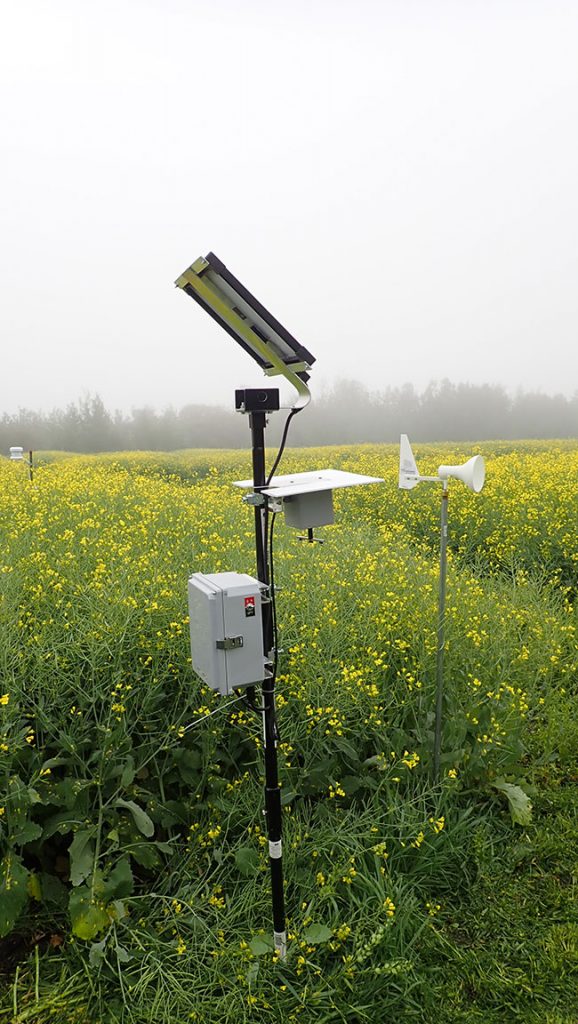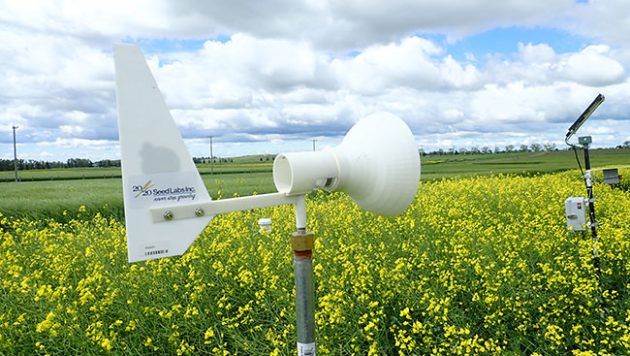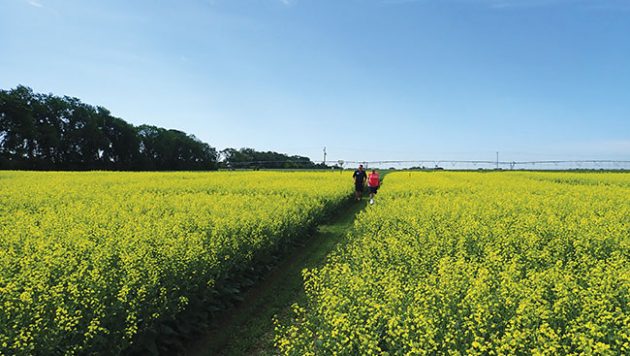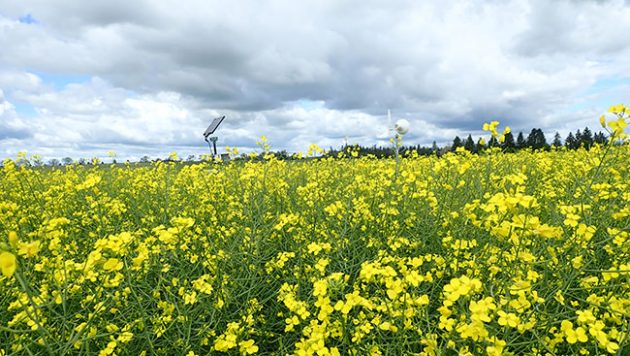
Features
Diseases
Canola
Improving Sclerotinia management in canola
Better risk management tools and fungicide treatments are coming to improve disease assessment, control and economics.
December 4, 2019 By Donna Fleury
 Sclerotinia fungicide timing experiment at Beaverlodge
Research Farm, Agriculture and Agri-Food Canada, Alberta, August 2019. In the foreground the rotorod sampler with a solar panel (left) and the Spornado (right), and in the background is the radiation shield housing for the external RH and
temperature sensors. Photos courtesy of Kelly Turkington.
Sclerotinia fungicide timing experiment at Beaverlodge
Research Farm, Agriculture and Agri-Food Canada, Alberta, August 2019. In the foreground the rotorod sampler with a solar panel (left) and the Spornado (right), and in the background is the radiation shield housing for the external RH and
temperature sensors. Photos courtesy of Kelly Turkington.
One of the biggest challenges of a disease like sclerotinia in canola is a grower needs to make the decision to spray fungicides well before they see any symptoms in the field. Sclerotinia stem rot is known as a major disease of canola that can cause significant crop yield and revenue losses. Early infections also cause more yield loss than later infections, and the economic benefit of a fungicide application is generally higher with early applications. With new advancements in molecular biology and DNA diagnostic techniques today, combined with new disease sampling tools and quick lab tests, researchers hope to be able to develop diagnostic and decision tools to improve the ability to assess risk and control sclerotinia disease with fungicides.
“Sclerotinia stem rot research and management has been a long-time priority and passion of mine since my start as a summer student in the early 1980s,” says Kelly Turkington, plant pathologist with Agriculture and Agri-food Canada (AAFC) in Lacombe, Alta., who also completed his MSc and PhD degrees at the University of Saskatchewan based on sclerotinia research.
“Over the years there has been quite a bit of research, building on the foundation from those early years and work of previous colleagues. Although we have made many advancements in understanding the disease cycle, fungicide treatments and development of assessment tools such as petal testing, being able to get timely information to make timely decisions remains challenging. Petal testing for example took five to seven days to get results and technologies for measuring inoculum loads weren’t available or were quite time consuming. However, recent advancements in new technologies and availability of DNA and other testing techniques is very exciting and we launched a new project in 2019 to develop more accurate monitoring and risk assessment tools and techniques to allow for more timely disease management and control using fungicides.”

Sclerotinia experiment with the Spornado and rotorod samplers in trials at Lacombe Research and Development Centre, Agriculture and Agri-Food Canada, Alberta, August 2019.
The project: comparing solutions
In this new three-year project funded via the Canadian Agricultural Partnership’s Canola AgriScience Cluster, Turkington and other research partners across Western Canada are looking at developing new management tools and evaluating various fungicide treatments and timings for better management of sclerotinia stem rot in canola. The project is being conducted at nine locations across Western Canada plus one site at Normandin, Que. In addition, University of Alberta master’s student, Eleanor McBain, is involved in the project and also looking at evaluating potential risk assessment tools in commercial fields in the Edmonton area.
“One of the main components of the project is to look at the impact of different fungicide timings and treatments to improve disease control and economics,” Turkington explains.
“One of the main components of the project is to look at the impact of different fungicide timings and treatments to improve disease control and economics,” Turkington explains. “We are testing a relatively new approach around fungicide timing developed over the past several years in the U.K. to see if there is an opportunity to implement the approach here in Western Canada. Their approach is to begin fungicide treatments and timing at the yellow bud stage, which is usually when the canola petals are just starting to get ready to emerge and the buds take on more of a yellowish tinge. This is the stage just before the start of flowering where there might be a few plants in the field with an odd petal here and there. A second application could then be made as the crop progresses to the full or late bloom stages if warranted.”

Sclerotinia experiment trials at the Canada-Saskatchewan Irrigation Diversification Centre/Agriculture and Agri-Food Canada, in Outlook, Sask., July 2019.
Testing fungicides
To test the approach in Western Canada, the study compared a total of nine fungicide treatments, with single or split applications of Proline (prothioconazole) at different timings, including a control treatment with no fungicides. With the single application trials, the treatments are made at the yellow bud stage, or yellow bud stage plus one, two, three or four weeks. For the dual application trials, the treatments are made at the yellow bud stage, or yellow bud stage plus again at two, three or four weeks. With dual applications, the chemicals are normally expected to be effective for two weeks or longer, therefore the yellow bud plus one week wasn’t included. For the project, researchers used only one fungicide product for the various treatments to remove any confounding factors in the research study with different active ingredients. However, Turkington emphasizes that growers should try to use different chemistries and options, particularly if making dual applications, and avoid using the same product multiple times, which could potentially increase the risk of fungicide resistance.
For the fungicide component, researchers will be assessing disease at the end of the season for all of the different fungicide timings, as well as measuring yields, seed weights and other factors to help determine the impact of fungicide application and timing. Researchers also want to know whether single versus dual treatments and which timings are more effective. Layered on top of the fungicide treatments is another project component focused on the assessment of pathogen inoculum loads throughout the season. Providing information about the spore load present in a field at various timings will help determine the risk of infection and the best timing of fungicide application.
Assessing spore load
“We are utilizing two different spore traps in the field, including a rotorod sampler and the Spornado technology from 20/20 Seed Labs,” Turkington says. The rotorod sampler provides a quantitative method of collecting spores and calculating nanograms of sclerotinia DNA per unit of volume of air per unit of time. This is paired with the Spornado spore trap, a very easy to use and relatively inexpensive passive technology that provides qualitative information. By pairing the rotorod sampler measurements with the Spornado spore trap at each site, we hope to be able to come up with some rules of thumb for DNA results from the Spornado that would equate to a low or moderate or high risk of infection. Growers and consultants would be able to use a Spornado spore trap in their fields to assess risk, and by applying these ‘rules of thumb’ potentially assist with decisions regarding fungicide timing and frequency. We are also using two quantitative PCR DNA tests to develop a quantitative estimate of spore loads directly from collected petals, one from Discovery Seed Labs and another from Quantum Genetix, both located in Saskatoon. These provide another potential option to assess stem rot inoculum load.”

Sclerotinia experiment with the Spornado and rotorod samplers in trials at Lacombe Research and Development Centre, August 2019.
A third component of the project is environmental monitoring at each site, collecting weather, precipitation, temperature and relative humidity within and above crop canopy. This information will be combined with the inoculum load in the air as the crop is coming into flower and throughout flowering to help to better understand changes in disease risk and subsequent crop response to fungicide timing and frequency.
Newer DNA tech
“Many of these DNA approaches allow a farmer or consultant to take a petal tissue or spore trap sample one day and have results back within 24 hours, which greatly improves their ability to make timely decisions regarding stem rot risk and fungicide use.”
“This is a very exciting time with the advancement in new tools and technologies that can quickly assess disease potential and help with management options and timing,” Turkington adds. “We are fortunate in Western Canada to have a range of commercial labs with the capacity to do DNA testing for a range of issues such as seed testing for Fusarium head blight, root tissue for clubroot or blackleg diseases and now for sclerotinia from aerial samples or petal tissues. Many of these DNA approaches allow a farmer or consultant to take a petal tissue or spore trap sample one day and have results back within 24 hours, which greatly improves their ability to make timely decisions regarding stem rot risk and fungicide use. It is really about bringing the newer DNA technologies together with the study of plant disease epidemiology. I’m passionate about this and the need to provide practical and timely decision-making tools to help farmers and crop consultants approach sclerotinia management and improve their ability to assess risk and control the disease with fungicides.”
The project will continue for another two years, and by the end researchers plan to have better tools and risk assessment strategies for more timely decision-making and timing of fungicide application. “Based on the potential yellow bud timing approach, inoculum load assessments and the impact of different fungicide timings and treatments, we look forward to being able to improve risk assessment, disease control and the economics of managing sclerotinia stem rot in canola.”